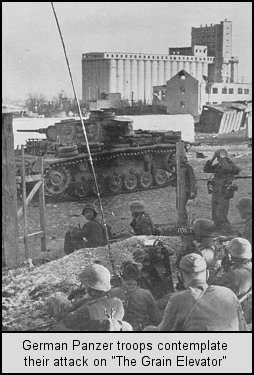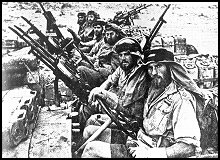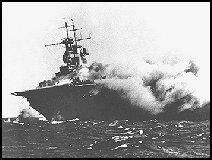September 8, 1942
Japanese forces open
a new offensive on the Kokoda Trail in an attempt to force the Owen Stanley
Ridge in their bid to take Port Morseby.
US
Marines and paratroopers attacked the Japanese postions at Taivu Point on
Guadalcanal.
Return to
the top
September 9, 1942
Field Marshal List is
sacked as commander of Army Group A as Hitler loses patience with the gains
being made by this force.
Japanese aircraft,
launched from submarines, bombard the woods near Brookings, Oregon forests with
incendiary munitions, starting several small fires.
British
troops fighting the French on Madagascar take control of the Mozambique Channel.
Return to
the top
September 10 1942
Red Army forces
attacking out of Leningrad halt their operations after taking heavy losses in
attack. At Stalingrad, Russian forces fall back deeper into the city as German
pressure continues and bloody house-to-house fighting continues.
The
German U-boat, U-69, laid 12 mines in the Chesapeake Bay. It would be the
last such mission on the Virginia coast in the war.
Return to
the top
September 11,
1942
Attacks in the
southern sector at Stalingrad continue with heavy fighting reported. German
forces approach "The Grain Elevator", a massive concrete structure
dominating the area, and are stopped cold by the fanatical defense of a mere 40
Russian Marines.
RAF Bomber command
raids Dusseldorf causing extensive damage.
Australian
forces stop the latest Japanese offensive at Ioribaiwa, on the Kokoda Trail, a
mere 32 miles from Port Morseby.
Return to
the top
September 12, 1942
The
German U-boat, U-156, torpedoed and sank the 19,695-ton British transport
Laconai. To the horror of the German crew, the ship carried 1800 Italian
POWs, captured in North Africa and heading for Canada. The German skipper,
Captian Hartenstein, attempted to save as many as possible, cramming 200
liberated prisoners into his boat. He then, over open channels, reported the
incident, calling for assistance and guaranteeing not to attack Allied ships who
respond. Later, American planes operating out of Ascension Island attacked the
submarine on the surface even though it displayed a huge Red Cross flag. Of the
original complement of 2732 on the Laconai, 1111 survived. The incident
led to the German "Laconia Order", prohibiting U-boat skippers from picking
up any survivors from their victims.
Return to
the top
September 13,
1942
British Commandos from the land, sea
and air, hit the German installations at Tobruk, Bengazi and Brace. The attacks
were a dismal failure and resulted in heavy losses to the British. The Royal
Navy destroyers Sikh and Zulu, along with the AA-ship Coventry
were sunk in action in the Tobruk operations, and several hundred marines were
killed. Damage to Tobruk's depots and port installations were minimal. The
raid on Brace succeeded in shooting up the town and some of the 30 planes at the
field with no losses. The attack on Bengazi was a bloody affair as surprise was
lost almost at the start of the attack and the commandos withdrew.
Two
Japanese battalions were destroyed (1200 Japanese casualties) in heavy fighting
at Henderson Field on Guadalcanal.
After
days of heavy house-to-house fighting in Stalingrad, a massive and concentrated
effort began as 6th Army hits the center of the city.
Return
to the top
September 14,
1942
Japanese forces struck Marine positions
on "Bloody Ridge" on Guadalcanal. The vicious fighting, often hand-to-hand
left 600 Japanese dead and 143 Marine losses.
The German 51st Corps
succeeds in driving through the city to the banks of the Volga, splitting the
Soviet defenses. Heavy counterattacks by the 62nd Army fail to
restore the situation.
Return to the top
September 15, 1942
Fierce fighting at Stalingrad centers on Mamayev Kurgan,
the dominant high ground overlooking city and the important ferries over the
Volga.
The aircraft carrier USS
Wasp , conducting air operations in support of the Marines on
Guadalcanal, is torpedoed by a Japanese submarine I-19off Espirtu Santo.
Two of the torpedoes strike the ship and detonate the aircraft fuel tanks and
magazine. The forward part of the ship was torn by explosions as flames raced
out of control. Within an hour of being hit, the order to abandon ship was made.
Less than an hour later, the crew was off. Wasp sank during the night after fire
completely gutted the ship. 1,941 men were saved.
Elements
of the US 32nd "Red Arrow" Division begin landing at Port Morseby
as McArthur prepares to expel the Japanese from New Guinea.
Return to the top
September 16, 1942
Heavy fighting at the
central railway station and yard at Stalingrad takes place. The buildings and
yards change hands several times during the day. Losses are heavy on both sides
in the fierce fighting.
Japanese
forces abandon Attu and move to Kiska.
Return to the top
September 17, 1942
The Governor General
of Madagascar calls on the British invasion force to negotiate an surrender. The
demands of the British were deemed unacceptable and the negotiations broke down
quickly.
German forces north
of Stalingrad open a new offensive in the northwest suburbs as fighting in the
center city bogs down.
Colonel
Leslie Grove is placed in charge of the Manhattan Project.
Return to the top
September 18, 1942
4000 Marines are
landed on Guadalcanal and for the first time in a month, full food rations were
provided to the troops.
In an attempt to
relieve pressure on Stalingrad, Red Army forces from the Voronezh Front, 250
miles from the city, open a massive offensive.
Col. Groves purchases
1250 tons of high quality Belgian Congo uranium ore stored on Staten Island. The
race to the A-bomb is on.
British forces land
on the east coast of Madagascar and occupy Tamatave.
A
German U-boat laid a dozen mines off Charleston, South Carolina. None were ever
struck.
Return to the top
September 19, 1942
Col.
Groves purchases 52,000 acres of land in Tennessee. The site will be the massive
weapons grade uranium enrichment facility known as Oak Ridge.
Return to the top
September 20, 1942
Newly
appointed commander, Dwight Eisenhower, declared that November 9 would be the
date for the Anglo-American invasion of North Africa - Operation Torch.
Return to the top
September 21, 1942
RAF Bomber command
hits Munich and the Saar Valley in heavy raids.
British
forces launch their first land offensive against the Japanese hitting in the
Arakan in Burma.
Return to the top
|
Editor's
Corner
The items found in
this section are comments from the editors of Project 60 and may not necessarily
reflect the opinions of bartcop.
The Grain Elevator
Fighting in a city is
without a doubt the hardest, most strenuous and dangerous place soldiers can ply
their trade. When our chickenhawk leadership claims that Iraq will be a
"cakewalk", consider this. Combat ranges shrink to feet instead of
miles in the confined spaces of a modern city. In the country one is lucky to
see their victims. In the city, you fight so close that you can smell your
opponent and feel his last breath in your face as your knife slides between his
ribs. This is the most brutal of arenas in the most brutal of endeavors.
And Stalingrad was
the worst of the worst. At this place on the Russian steppes, the most
technologically advance, best trained and equipped army the world had yet known
came to grips with one of the poorest equipped, and marginally led forces. The
city evened the fight. The technologically advanced and highly trained army was
beaten to a bloody pulp.
In this fight,
isolated bands of Russian soldiers would often fight on, their commanders
writing them off as lost. One such band, hold itself up in the massive concrete
grain elevators 60 years ago this week. Survivors from both sides, left behind
their notes. They are reproduced here.

The German's
story
September 16:
Our battalion, plus tanks, is attacking the elevator, from which smoke is
pouring - the grain in it is burning, the Russians seem to have set light to
it themselves. Barbarism. The battalion is suffering heavy losses. There are not
more than 60 men left in each company. The elevator is occupied not by men but
by devils that no flames or bullets can destroy.
September 18:
Fighting is going on inside the elevator. The Russians inside are condemned men;
the battalion commander says 'the commissars have ordered those men to die in
the elevator.' If all the buildings of Stalingrad are defended like this, then
none of our soldiers will get back to Germany.
September 20: The
battle for the elevator is still going on. The Russians are firing on all sides.
We stay in our cellar; you can't go out into the street. Sergeant-Major
Nuschke was killed today running across the street. Poor fellow, he's got
three children.
September
22:Russian resistance in the elevator has been broken. We found about forty
Russians dead in the elevator building. Half of them were wearing naval uniform
- sea devils. One prisoner was captured, seriously wounded.
That wounded soldier
was Andrey Khozyaynov of the Marine Brigade and he wrote this
I remember on the
night of the 17th, I was called to the battalion command post and
given the order to take a platoon of machine-gunners to the grain elevator and,
together wit the men already in action there, to hold it come what may. We
arrived that night and presented ourselves to the garrison commander. At that
time the elevator was being defended by a battalion of not more than thirty to
thirty-five guardsmen. Eighteen well-armed had arrived from our platoon.
At dawn enemy
tanks and infantry, approximately ten times our numbers, launched an attack from
the south and west. After the first attack was beaten back, a second began, then
a third, while a reconnaissance 'pilot' plane circled over us. It corrected
the fire and reported our position. In all, ten attacks were beaten off on
September 18.
In the elevator,,
the grain was on tire, the water in the machine-guns evaporated, the wounded
were thirsty, but there was no water. This is how we defended ourselves
twenty-four hours a day for three days. Heat, smoke, and thirst - all our lips
were cracked. During the day many of us climbed up to the highest points in the
elevator and from there fired on the Germans; at night we came down and made a
defensive ring round the building. We had no contact with other units.
September 20th
arrived. At noon twelve enemy tanks came up from the south and west. We had
already run out of ammunition for our anti-tank rifles, and we had no grenades
left. The tanks approached the elevator from two sides and began to fire at our
garrison at point-blank range. But no one flinched. Our machine-guns and tommy-guns
continued to fire at the enemy's infantry, preventing them from entering the
elevator. Then a Maxim, together with the gunner, was blown up by a shell, and
the casing of the second Maxim was hit by shrapnel, bending the barrel. We were
left with one light machine-gun.
The explosions
were shattering the concrete; the grain was in flames. We could not see one
another for dust and smoke, but we cheered one another with shouts. German tommy-gunners
appeared from behind the tanks. There were about 200 of them. They attacked very
cautiously, throwing grenades in from of them. We were able to catch some of the
grenades and throw them back. On the west side of the elevator, the Germans
managed to enter the building, but we immediately turned our guns on the parts
they occupied. Fighting flared up inside the building. We sensed and heard the
enemy soldiers' breath and footsteps, but we could not see them in the smoke.
We fired at sound.
At night, during a
short lull, we counted our ammunition. There did not seem to be much left. We
were surrounded. We decided to break out to the south. To begin all went well.
We passed through a gully and crossed a railroad line, then stumbled on an enemy
mortar battery. The Germans scattered, leaving behind their weapons, but also
bread and water. 'Something to drink!' was all we could think about. We
drank our fill in the darkness. We then ate the bread we had captured and went
on.
But alas, what
happened to my comrades I don't know, because the next thing I remembered was
waking in a dark, damp cellar. A door opened, and in the bright sunlight I could
see a tommy-gunner in a black uniform. On his left sleeve was a skull. I had
fallen into the hands of the enemy.
1941 Archive:
June
| July
| August | September
| October | November | December
1942 Archive:
January
| February | March
| April | May | June
| July | August
Special Editions:
Pearl
Harbor | The Doolittle Raid | Midway
Editor's
Corner Archive:
The
Past Through Tomorrow "It
is quite frightening to realize just how similar our nation's actions
have been and appear to be heading when compared this way..."
Afghanistan
and Vietnam: When the "war against
terrorism" began, many knowledgeable people warned that our operations
in Afghanistan would turn into another Vietnam.
Want to Win - Think Before You Lash Out
- "If we are serious about taking the war to the enemy, it is time to
look ..."
The
First Fight Against Fascism - We must remember the Spanish Civil
War also.
Arguing
Victory - "... Each nation who fought against fascist tyranny in WWII brought with it
part of whole needed to defeat that evil..."
War, Glory,
Honor and Remembrance - "War is a
brutal and savage insult on human society..."
The
First Casualty... in time of war, those in power are even more inclined to hide the truth,
since that truth is often manifest in the most gruesome and terrible
acts.
Those wishing to
contribute items. stories or comments should contact D.A.
Friedrichs
|



